Menus
- What you must remember
- Themore
- Theless
- Prices
- Make yourYamaha 1000 GTS 1994
- Opinion
- Replaces
- Performances
- The technical aspect
- Competitors
- Gallery
- Related articles
Yamaha’s new sportivo-GT is a new kind of motorcycle. Not in its general concept but in its conception. Another competitor for the CBR 1000 F and ZZR 1100, some would say. Perhaps. But the GTS is above all the first mass-market machine without a telescopic fork..
WHAT ! There is no fork on this motorcycle. As unbelievable as it may sound, the GTS does not come equipped with the universal element of steering and front suspension known as the fork. In absolute terms, this is not the first motorcycle to do without it. Others before it have tried it, notably the Bimota Tesi, but the Yamaha is the first to use another system in series. So what is it?
This is the combination of a single sided swingarm at the front and a steering arm supporting the front wheel. The system being worthy of a star war type gas plant, we will be satisfied to say that this kind of front axle makes it possible to greatly reduce the variations of hunting and wheelbase while having a natural anti-dive effect. If it makes it possible to avoid the congenital defects of the conventional fork (lack of rigidity, important lever arm requiring large part-cycles, constant variations of the geometry of the machine, etc …) and to dispense with an imposing hyper reinforced frame, this system is not generous in turning radius. That of the GTS is not better than that of the FZR. The frame also has nothing in common. Called Omega and made up of aluminum foundry parts, it wraps around the engine block with this very particular shape: (pretty much …). A unique structure refocusing the masses, lowering the center of gravity and a smaller footprint compared to the double beam.
And which engine did they choose to drive this surprising machine? A well-known and recognized mechanism: the Genesis 4-cylinder of the 1000 FZR. Same displacement but a reworking to give it a more sport-GT face. The power is supplied by 4 injectors and the valve opening map differs from that of the sports car. No EXUP but a couple all the same all the same favored because more than 1 mkg than that of the sportswoman. The GTS is also presented as a “clean” motorcycle – it is equipped with a catalytic converter with lambda sensor. A first on a Japanese.
The whole structure, by design, is conducive to improved stability and formidable efficiency of the braking system. Yamaha has also equipped the front wheel with a single disc, but ventilated, large diameter and clamped by a caliper with 6 opposed pistons. The ABS can come as a reinforcement if necessary (optional).
A fairing studied in the wind tunnel, 2 bubbles of different height available, a generous saddle, a glove box embedded in the tank, large side cases provided in 2 sizes (TV design …), the GTS is clearly dedicated to the road. However, its innovative (and confusing) technology and high-end positioning are double-edged advantages. The technique can attract the curious as well as put off traditionalists, and its price limits its clientele. The public in the know will immediately see the true identity of the GTS: the most innovative motorcycle of the decade.
The analysis of the Yamaha GTS 1000 by Tanthallas:
At the start of the 1980s, James Parker, a former American motorcyclist and very inspired handyman, imagines and files the patents for a single-sided swingarm front suspension which must eliminate all the perverse effects of a telescopic fork: plunging under braking, influence of the suspension on the steering…
After putting it into practice on a Honda XL 600-based prototype, Parker contacted the US representatives of the Japanese manufacturers. After a refusal from Honda (who subsequently preferred to buy the Elf patents), the inventor submits his prototype to Yamaha who will have the machine tested by Wayne Rainey. After a second prototype based on Yamaha FZ and a long wait, Yamaha signs a contract for the research and development of this suspension. From this study was born the GTS 1000cc in 1992 (marketed in France in 1993).
This new motorcycle is placed on the market of large luxury and High Tech road. It is not only equipped with the “Parker” suspension and the Omega frame developed to accommodate this single-arm front suspension, but is also equipped with a new electronic injection, a catalytic converter, ABS (optional) as well as a 6-piston front brake caliper (a first for Yamaha).
The cycle part, although revolutionary, is not in its behavior poles apart from the rest of the motorcycle production. The front suspension brings an undeniable advantage on the braking phases and in terms of general comfort. However, the picture is not perfect either and this system generates some small flaws. Thus, the steering is a little steeper than with a conventional fork. The force to be exerted on the handlebars is a little more important. In addition, the GTS shows some difficulty in tackling certain obstacles such as climbing a curb. It seems that this problem is due to the design of the front suspension sketch which causes poor clearance of the wheel when it encounters an obstacle..
On the other hand, once on the road, the bike is perfectly stable, provides great comfort for both rider and passenger and has very reassuring reactions when braking hard. Here, the suspension of James Parker proves his interest.
Regarding braking, if the single-sided arm has imposed the presence of a single disc, this 320 mm clamped by a caliper with 6 opposed pistons is excellent. It combines power, progressiveness and feeling. The anti-dive effect of the single-sided arm makes it possible to maintain a perfect attitude and to use the rear brake serenely; the mass transfer effect being less sensitive. Small defect, all the same, the direction still tends to harden a little more during the big braking.
As for the engine, the GTS inherited the muscular 1000cc of the Sportive FZR equipped for the occasion with a latest generation electronic injection. He loses his Exup but gains a catalyst. In 100 horsepower configuration, the engine is flexible and is ideally expressed in low and mid-range. If the engine takes its turns well, it is not necessary to push it to its limits. It gives its best up to 8,000 rpm. In short, an engine designed for a large road.
And it is true that the GTS perfectly meets its objective. Its behavior is reassuring and the engine inexhaustible. Fairing protection is very good and allows relaxed driving at high speeds.
This luxury roadster is a very well-born motorcycle. Unfortunately, she will not really convince the public. Endowed with great qualities that it charges quite dearly, the GTS will still remain in the Yamaha catalog for 6 years (released in 1999) with a success of esteem, more than a commercial tidal wave. The front suspension will, however, not have a follow-up at Yamaha to this day..
What you must remember
Themore
Theless
Prices
12,100 €
Price
nine
Compare
the credits
Make
yourYamaha 1000 GTS 1994
Estimate, calculate and compare the cost of insuring your motorcycle.
Calculate the cost of
insurance
Test the price of the motorcycle insurance specialist
Opinion
on 11 opinion
users
Read the reviews
Replaces
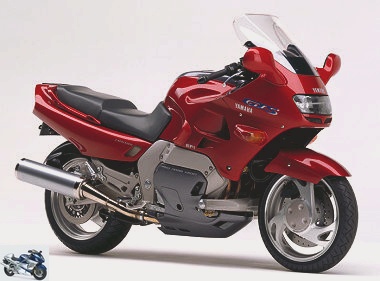
1000 GTS 1993
Model marketed in
1993
1994
1995
1996
1997
1998
Performances
-
Max speed:
225 km / h -
Acceleration
0 to 100: 3.80 s -
Consumption
medium: 6.40 l
The technical aspect
Yamaha 1000 GTS 1994
- Frame
- Frame: Omega type in aluminum with secondary structures in steel tubes
- Tank: 20 liters
- Seat height: 790 mm
- Length: 2170 mm
- Width: 700 mm
- Height: 1320 mm
- Wheelbase: 1495 mm
- Dry weight: 246 kg
- Train before
- horizontal swing arm and vertical strut, combined side spring-shock absorber, deb: 116 mm
- 1 disc Ø 320 mm, 6 piston caliper
- Front wheel:
130/60
– 17
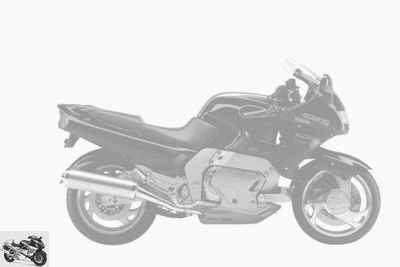
- Transmission
- 5-speed gearbox
- Secondary chain transmission
- Rear axle
- Mono-shock absorber, deb: 130 mm
- 1 disc Ø 267 mm, 2 piston caliper
- Rear wheel:
170/60
– 17
- Motor
- 4 Cylinders
in line
, 4 stroke - Cooling: Liquid cooling
- Injection Ø nc
- 2 ACT
- 5 valves per cylinder
-
1,002 cc
(75.5 x 56 mm) -
102
ch
at 9000 rpm -
10.80 mkg
at 6500 rpm - Weight ratio /
power
: 2.41
kg / hp - Compression: 10.8: 1
- Crit’air:
Detached pieces
exhaust
motor
fluid
electricity
filtration
braking
chain kit
Competitors
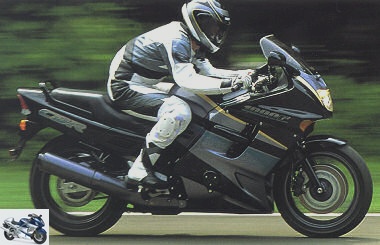
Honda CBR 1000 F 1994
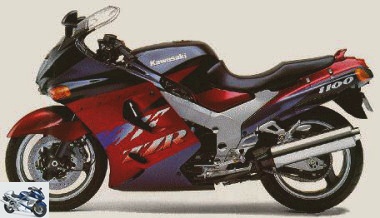
Kawasaki 1100 ZZR 1994
Gallery
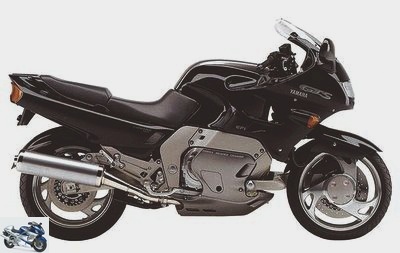
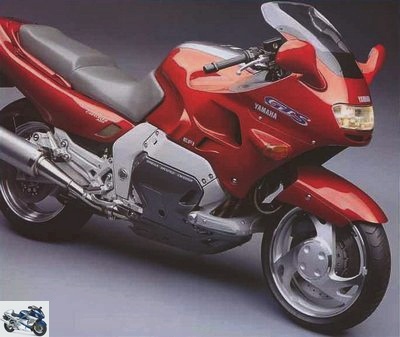

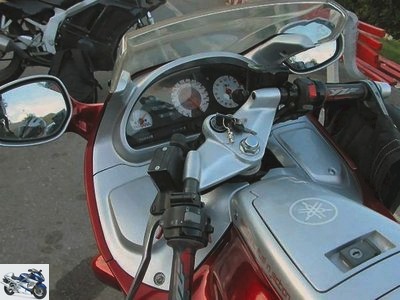
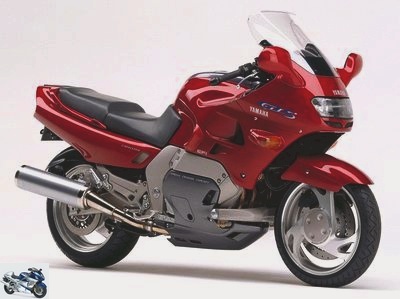
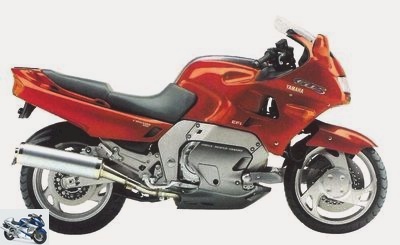
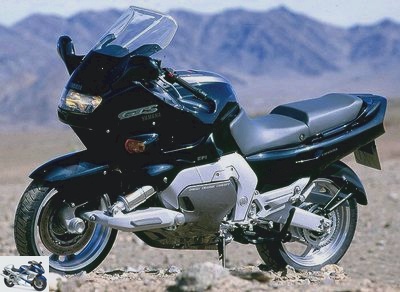
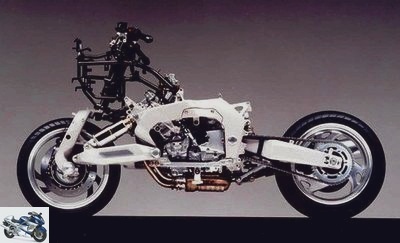
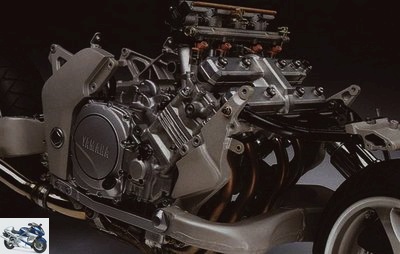
Related articles
-
Yamaha’s new sportivo-GT is a new kind of motorcycle. Not in its general concept but in its conception. Another competitor for the CBR 1000 F and ZZR…
-
Yamaha’s new sportivo-GT is a new kind of motorcycle. Not in its general concept but in its conception. Another competitor for the CBR 1000 F and ZZR…
-
Yamaha’s new sportivo-GT is a new kind of motorcycle. Not in its general concept but in its conception. Another competitor for the CBR 1000 F and ZZR…
-
Yamaha’s new sportivo-GT is a new kind of motorcycle. Not in its general concept but in its conception. Another competitor for the CBR 1000 F and ZZR…
-
Yamaha’s new sportivo-GT is a new kind of motorcycle. Not in its general concept but in its conception. Another competitor for the CBR 1000 F and ZZR…
-
1986, Suzuki releases a second missile on the road, this time in 1100cc. Yamaha, which was already stolen from the limelight by the GSX-R 750 the…
-
1986, Suzuki releases a second missile on the road, this time in 1100cc. Yamaha, which was already stolen from the limelight by the GSX-R 750 the…
-
1986, Suzuki releases a second missile on the road, this time in 1100cc. Yamaha, which was already stolen from the limelight by the GSX-R 750 the…
-
1986, Suzuki releases a second missile on the road, this time in 1100cc. Yamaha, which was already stolen from the limelight by the GSX-R 750 the…
-
1986, Suzuki releases a second missile on the road, this time in 1100cc. Yamaha, which was already stolen from the limelight by the GSX-R 750 the…